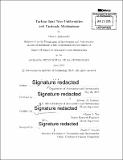Turbine inlet non-uniformities and unsteady mechanisms
Author(s)
Jedamski, Devon (Devon James)
DownloadFull printable version (8.621Mb)
Other Contributors
Massachusetts Institute of Technology. Department of Aeronautics and Astronautics.
Advisor
Edward M. Greitzer and Choon S. Tan.
Terms of use
Metadata
Show full item recordAbstract
The effect of axial turbine stage inlet non-uniformities are examined through two model problems: wake attenuation and hot streak processing. In the first, twodimensional calculations (RANS and URANS) are used to identify the mechanisms contributing to upstream stator wake attenuation through a turbine blade row. For a representative turbine rotor, pitch and time-averaged wake attenuation by 74% percent is demonstrated at one quarter chord downstream of the trailing edge. Near the pressure surface, the wake stagnation pressure increases by up to 42% above the freestream stagnation pressure. The mechanisms identified are a localized reduction in flow-through time for wake fluid near the pressure surface, compared to the freestream, and an unsteady pressure field (Op/&t) in the rotor reference frame that increases work extraction in the freestream relative to wake fluid. For the second model problem, three-dimensional calculations (RANS and URANS) identify a difference in turbine efficiency sensitivity to thermal distortion between a geometry with no tip gap and a geometry with a finite tip gap. The turbine with a tip clearance is 2.5 times less sensitive, in terms of efficiency decrease, to an inlet hot streak. For the tip gap and no tip gap geometries, the efficiency drops by 0.75% and 1.86% respectively for a peak temperature non-uniformity equal to 0.6 times the combustor temperature rise. The difference in efficiency decrease, due to hot streak, between the two geometries is linked to a reduction in tip leakage mixing losses caused by changes in relative rotor inlet flow angle with and without hot streak.
Description
Thesis: S.M., Massachusetts Institute of Technology, Department of Aeronautics and Astronautics, 2015. Cataloged from PDF version of thesis. Includes bibliographical references (pages 87-88).
Date issued
2015Department
Massachusetts Institute of Technology. Department of Aeronautics and AstronauticsPublisher
Massachusetts Institute of Technology
Keywords
Aeronautics and Astronautics.